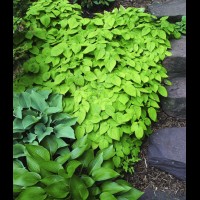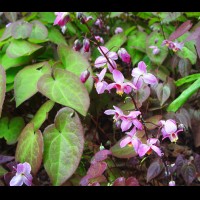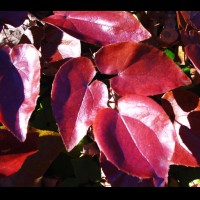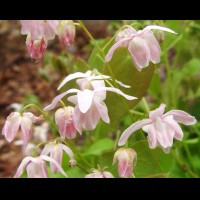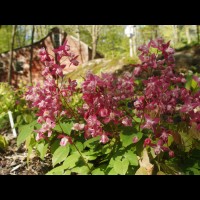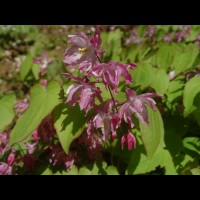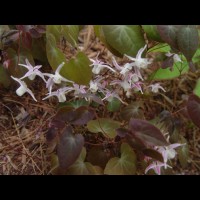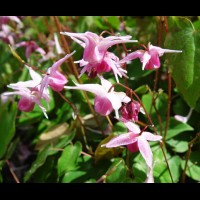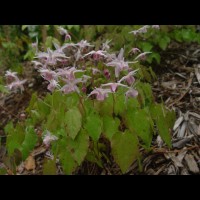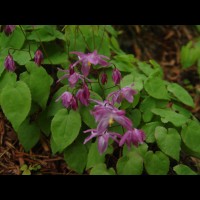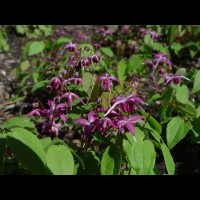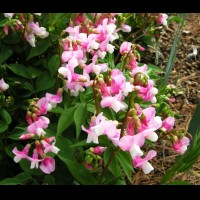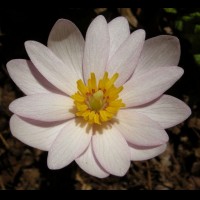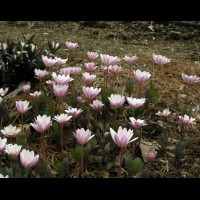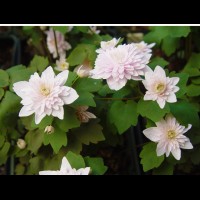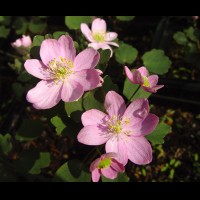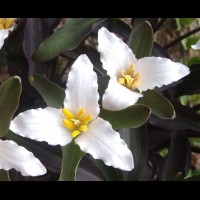Epimedium brachyrrhizum
Epimedium brachyrrhizum (Several clones/Cc. numbers)
Discovered in 1994 in Guizhou Province, China, it is one of the shortest species at only 6-8" tall, and among the largest flowered and earliest to bloom, with lavender-pink flowers nearly 2" across! New leaflets may be handsomely mottled with red-maroon in spring. Dark evergreen leaflets have a distinct corrugated surface, and many clones take on maroon overtones in fall. Not available this year.
Epimedium brachyrrhizum 'Karen'
Epimedium brachyrrhizum ‘Karen’ (Cc. 940526)
After years of trialing this plant against other superior forms of E. brachyrrhizum this stands out as the best for its prolific, large flowers in a soft shade of lavender-pink, combined with large leaves, heavily mottled with deep cranberry-rose in the spring. E. brachyrrhizum just happens to be one of my favorite Epimediums, so Darrell named this outstanding clone in my honor. 7” tall. Evergreen.
Epimedium grandiflorum
E. grandiflorum (Cc. 920009) (Synonym: E. macranthum)
The typical form of the species in the U.S., with rosy inner-sepals, and creamy-white spurs and cup. The small new spring leaflets have a brown-purple cast to them that nicely complements the flower color. 7" tall in bloom, with a second growth flush to 14".
Epimedium grandiflorum 'Bicolor Giant'
E. grandiflorum ‘Bicolor Giant’ (Cc. 970206)
Bold, cheerful and bright flowers and later the large leaves both make a nice show from a distance. The large flowers exhibit in-curved sugary pink spurs under wide, deep raspberry sepals. The flowers bloom from underneath the leaves, but are produced in such profusion, that they are showy nonetheless.
After bloom, the large new spring leaflets blush with red before turning to their summer green. Another giant red similar to ‘Red Queen’ and ‘Orion’, but with a bi-colored bloom. Acquired in from Gotemba Nursery, Japan in 1997 as a “pink grandiflorum”. 16” tall in flower. It has exhibited yellow, rusty orange and maroon fall colors here in Massachusetts. Forms a substantial clump that reads as a small shrub in the perennial border.
Epimedium grandiflorum 'Circe'
E. grandiflorum ‘Circe’ (Cc. 950244)
***2006 Cobblewood Introduction***
Beautiful large rose-red flowers accented with white spur tips have caught the eye of many a visitor to our open nursery weekends. This cultivar has much the same characteristics to recommend it as Epimedium grandiflorum ‘Yubae’ but with 2-3 times the number of bloom stems held above the foliage, and a shorter stature. Heavily flowered with a slightly darker cast to the young foliage. Medium-sized leaflets form a mound to 13”. An early bloomer hybridized by Darrel Probst.
Epimedium grandiflorum 'Mt. Kitadake Red'
E. grandiflorum ‘Mt. Kitadake Red’ (Cc. 960020)
A darling little plant, beginning its bloom with leaves only 5” tall. The large, rose-red flowers are held above the foliage at 7” high. A second flush of leaflets follows on stems to 10”. Each small leaflet is tinted with bronze to dark reddish-purple in spring. This clone has exhibited pink and yellow fall color in the nursery.
Epimedium grandiflorum 'Princess Susan'
E. grandiflorum ‘Princess Susan’ (Cc. 960044)
***1999 Cobblewood Introduction***
A beautiful, large-flowered selection from Harold Epstein’s garden, named after his daughter. Flowers are a crisp contrast of cherry-rose inner-sepals and pure white petals/spurs against small, bright green leaflets. Foliage grows more horizontally than that of other Epimediums. 8” in bloom with a second growth flush to 13”. A late bloomer.
Epimedium grandiflorum 'Sirius'
E. grandiflorum ‘Sirius’ (Cc. 920024)
A 1990 Dick Weaver introduction, ‘Sirius’ originated as a seedling in Harold Epstein’s garden. The large and delicate palest of pink flowers float above small, distinctively light green leaflets. Often only 5” tall in bloom, with a second flush of growth to 10”. Blooms at the "tale-end" of the Epimedium season.
Epimedium grandiflorum 'Tama No Genpei'
E. grandiflorum ‘Tama No Genpei’ (Cc. 950039)
A floriferous, showy Japanese selection with masses of large, crisp, bi-colored lavender/pink and white flowers held above the foliage. The lovely flowers paired with attractive purple-flecked new spring foliage gives the plant a very soft look in bloom. First blooms are held on 8” stems, with stems elongating to 16”. Small leaflets.
Epimedium grandiflorum 'Yubae'
E. grandiflorum ‘Yubae’ (Cc. 920022)
(Synonyms: ‘Crimson’, 'Crimson Beauty’, 'Rose Queen’)
One of my favorites, this plant is often mislabeled as ‘Rose Queen’. It arrived in the west many decades ago, already given the name ‘Yubae’ in Japan, but with only Japanese characters to go by and no translation it was probably soon given an English cultivar name. Incidentally, this same plant suffered a third renaming in the U.K. when another plant, ‘Tama No Genpei’, was going around as ‘Rose Queen’ so it was re-named ‘Crimson Beauty’, perpetuating the confusion.
Yubae’s beautiful large rosy-red flowers have white spur tips. This bright flower color can read from a long distance in the garden. The young foliage, purple-bronze in spring, is only 8” tall at first bloom. A second flush of flowers and foliage reaches 18”. Early bloomer.
Epimedium leptorrhizum 'Hubei Treasure'
Epimedium leptorrhizum ‘Hubei Treasure’ (Cc. 001259)
***2005 Cobblewood Introduction***
Traveling along the Sichuan/Hubei Province border in China on a transitional day between target locations in November of 2000, Darrell stopped to stretch his legs. There he found an Epimedium in the cracks of a short cliff along a farmer’s field. With long hairs on the leaves and long rhizomes, he identified it as E. leptorrhizum, and collected a few samples. Fortunately this clone has larger flowers with near-white spurs backed by rich pink inner sepals, a striking deviation from the typical pale lavender-pink blooms of this species. The evergreen leaves are larger than those of the species. Spreads by 2-4" rhizomes.
Epimedium pubigerum Cc. 920029
E. pubigerum (Cc. 920029)
Attractive small, round, heart-shaped leaflets with a matte surface, a wavy edge and a bronze overlay in spring, form on stems 8 to 10" tall. Full sprays of very small, pink-flushed, creamy-white flowers hover well above the leaves at 16-20". Early bloomer that initially stays in a clump, but with age, throws short 1-3" rhizomes, with occasional longer ones. Semi-evergreen.
Epimedium sempervirens 'Mars'
Epimedium sempervirens ‘Mars’ (Cc. 920035)
A rare, rose-red form of this species, named by Dick Weaver from a plant he purchased from Japan. 6” tall in bloom with a second flush to 10” tall. Medium-sized leaflets. When grown well, ‘Mars’ produces up to 30 or more flowers per stem, forming a dense head. Very showy. Medium/large, dark rose-red flowers. Rusty red/salmon fall color.
Epimedium "Asiatic Hybrid"
Epimedium “Asiatic Hybrid” (Cc. 950166)
Washfield Nursery in England sold mixed seedlings of Asian parentage under the umbrella name “Asiatic Hybrid”, where Dan Hinkley originally purchased this clone. Tall sprays of delicate, small, pale pink flowers with deeper cups bloom above medium-sized, spring leaflets of a metallic pinkish-maroon hue. Blooms reach 12-15”. Semi-evergreen, arrow-shaped leaflets to 10".
Epimedium 'Beni Chidori'
E. 'Beni Chidori' (Cc 050001)
An attractive Japanese variety, given the name "a thousand red-birds chirping' and that is what it truly looks like in bloom- clusters of showy reddish-purple flowers with sepals a lighter shade of the same color. The medium-sized leaflets form a mound of bright green foliage to 10 in bloom, 18-20" high in second growth. Spurs are tipped in white. A very floriferous clone.
Epimedium 'Enchantress'
Epimedium ‘Enchantress’ (Cc. 950021)
A stunning cultivar from Washfield Nursery in England, a result of Elizabeth Strangman’s cross of E. dolichostemon by E. leptorrhizum. Beautiful silvery-pink, medium-sized flowers bloom well above long, narrow, evergreen leaflets (up to 10" in height) with undulating margins. Rhizomes grow 2-4” a year. Reliable deep red fall/winter color.
Epimedium 'Flamingo Dancer'
E. ‘Flamingo Dancer’ (Cc. 031432)
A Japanese selection named by Diana Reeck of Collector’s Nursery. Produces clusters of two-toned bright pink flowers. A narrow, deep cherry pink cup moves into lighter pink spurs subtended by darker sepals. Bright white spur tips make for a lively color combination. Each full panicle of bright flowers arches gracefully out over the beautifully speckled spring foliage. 10” high.
Epimedium 'Hot Lips'
Epimedium ‘Hot Lips’ (Cc. 031434)
An E. acuminatum hybrid from Diana Reeck of the former Collector's Nursery, with multi-toned flowers of hot pink with the long spurred petals that are decidedly hotter than the broad sepals. Flower stems are tinged burgundy red. Long narrow foliage emerges a reddish pink. Given a bit of bright shade or moderate sun in the north, the plant can reach 20” high. Its bright blooms and bold semi-evergreen foliage draws your eye from quite a distance.
Epimedium 'Kaguyahime'
Epimedium ‘Kaguyahime’ (Cc. 950225)
From Japan (via Mikinori Ogisu & Robin White) comes this delicately beautiful hybrid of E. acuminatum and E. dolichostemon. 15-18” stems carry sprays of small flowers with dark reddish-purple spurs and light rose-pink inner sepals. Long, slender arrow-shaped, medium-sized leaflets are jagged edged and beautifully mottled with various shades of red in spring. Vigorous for an semi-evergreen Epimedium, it is one of my favorites, and is named after a popular Japanese folk princess.
Epimedium 'Pink Champagne'
Epimedium ‘Pink Champagne’ (Cc. 990618)
***2007 Cobblewood Introduction***
Perhaps the most all around beautiful Epimedium of those that Darrell has developed so far! Upright, heavy flowered panicles of pink and raspberry flowers float well above handsome, mottled foliage in spring. Medium pink sepals cap the top of each widely-arched spur. From the yellow spur tips that reveal their treasure of nectar, the color changes from white to a rich, berry pink, as if the cup was dipped in raspberry sorbet. Elongated, evergreen medium-sized arrow-shaped leaflets contrast purple mottling against a green background. A vigorous grower, it puts on an incredible show with occasional re-bloom if it is happy in its environment. 12" tall with flower stems reaching 16".
Epimedium 'Pretty In Pink'
Epimedium ‘Pretty in Pink’ (Cc. 130001)
This 2012 Plant Delights Nursery introduction by Tony Avent is a vigorous E. grandiflorum hybrid with exceptional foliage. Small clusters of large, showy flowers with pink spurs and a raspberry cup are held just above the leaves during the mid-late Epimedium bloom season.
The new spring growth is patterned with subdued maroon flecks, eventually hardening off as handsome, glossy, medium-sized green leaflets, followed by a flush of blush pink second growth foliage. Tony describes the leaflets as "tardily deciduous"-- what I call "semi-evergreen". One of the best for thick, lustrous summer foliage. To 12".
Epimedium 'Short Story'
Epimedium ‘Short Story’ (Cc. 170040)
***2019 Cobblewood Introduction***
A showy, robust, new hybrid from Massachusetts breeder Mark McDonough. This unique selection combines the best of evergreen E. brachyrrhizum and deciduous E. grandiflorum. Spring emergence starts with an upright filigree of bronze stems and small leaflets, giving high visibility to luscious clusters of large silvery pink flowers with conspicuously down-turned spurs. As the leaves expand they are mottled in soft red. The flowers are held high and more prominently than in brachyrrhizum, for a fine display. The second flush of semi-evergreen foliage is just as dramatic as the plant is in bloom, boldly marked with bright red over chartreuse green.
Epimedium x rubrum
Epimedium x rubrum (Cc. 920042)
Often listed as variety or cultivar of E. alpinum, it is said to be a hybrid between E. alpinum and E. grandiflorum, however the colorful spring foliage could only have come from E. sempervirens ‘Violet Queen’. This slow-spreading hybrid (rhizomes 2-4”) is an excellent groundcover, forming a thick mass of medium-sized leaflets on 16” stems. Foliage flushes cherry-red in spring. The abundantly produced medium-sized flowers have red sepals, creamy-yellow spurs. Commonly referred to as drought-tolerant, but I haven't observed that to be true.
Epimedium x rubrum 'Sweetheart'
Epimedium x rubrum ‘Sweetheart’ (Cc. 930007)
***1997 Cobblewood Introduction***
This cultivar easily rivals Hosta as a bold textural garden accent. The first of Darrell Probst's Epimedium introductions, resulting from a 1991 cross he made between E. sempervirens ‘Candy Hearts’ and E. alpinum. Flowers with dark rose-red sepals bloom above and below the leaves. Leaflets are much larger, darker green and more rounded than is typical. Large, shiny new leaflets bear a thin red rim in spring. Semi-evergreen. 16" tall. Foliage is far superior to E. x rubrum, and the plant is much more drought-tolerant. Spreads by 2-4" rhizomes.
Epimedium x versicolor 'Cherry Tart'
Epimedium x versicolor ‘Cherry Tart’ (Cc. 970064)
***1999 Cobblewood Introduction***
A spontaneous seedling originating in the garden of Judy Springer, formerly of Great Falls, VA. Erect stems sport numerous, outfacing flowers. Large, medium-pink inner sepals back flaming, cherry-red spurs with a bright, lemon-rimmed cup. Spreads slowly by 2-4” long rhizomes. Medium-sized leaflets are handsomely flushed with reddish-purple in spring with a mustard tone that changes to a dark burgundy blush in the fall. 12-15”. Blooms early and is drought-tolerant. Semi-evergreen.
Epimedium x versicolor 'Strawberry Blush'
E. x versicolor ‘Strawberry Blush’ (Cc. 990615)
***2004 Cobblewood Introduction***
Wide, antique pink sepals brushed with rose streaks back a cheerful lemon-yellow cup, which deepens to rose purple short, curved spurs. The soft pastel flowers blend beautifully with the pinkish maroon mottled new spring leaflets. Darkest at the edges, the color fades to green at the center of small/medium-sized leaflets, before turning entirely green. Handsome, medium green, glossy summer/fall foliage. Particularly drought tolerant. Semi-evergreen. Flowers/foliage to 10”. Spreading rhizomes grow 2-4" per year. Drought-tolerant.
Epimedium x youngianum 'Baby Doll Pink'
E. x youngianum ‘Baby Doll Pink’ (Cc. 950072)
***1999 Cobblewood Introduction***
Either an unlabeled Japanese cultivar or a seedling from Harold’s garden. Small, spurless flowers are dark pink in bud, opening a pale pink edged in medium pink. A truly pink-flowered Epimedium. Extended bloom above small, light green leaflets with a pink tint in spring give this plant real garden merit. Only 3” tall in first flower, it continues to produce more flowers to 9” tall.
Epimedium x youngianum 'Be My Valentine'
E. x youngianum ‘Be My Valentine’ (Cc. 950231)
***1999 Cobblewood Introduction***
Named in honor of the late Betty Valentine of Berlin, CT, at the request of the CT chapter of NARGS, in celebration of her 90th birthday in1998. Betty loved Epimediums. She grew them most of her life. Covered in bright blooms at only 5-6”, the small-medium-sized flowers have deep rose-pink inner-sepals and white petals flushed rose, with very short, white spurs. Small leaflets. Second growth flush to 14” tall. Early bloomer.
Epimedium x youngianum 'Beni Kujaku'
Epimedium x youngianum ‘Beni Kujaku’ (Cc. 960011)
A fanciful Japanese "double-flowered hybrid whose name--literally translated-- means "Red Peacock". The cup is completely open, mimicking the inner-sepals in size and shape with short protruding spurs. Each flower part has a white or pale pink interior, the perimeter suffused with dark rose pink. Medium-sized “double” flowers bloom above small, medium green leaflets. 6” tall in bloom, second growth flush to 12”.
Epimedium x youngianum 'Hagoromo'
E. x youngianum ‘Hagoromo’ (Cc. 980091)
New growth is flushed purple, and matures to olive-green with a contrasting white star pattern at the veins near the leaf base. Medium-sized dainty white flowers appear among the foliage on deep-red petioles. The flowers are backed by narrow lavender/pink sepals, each edged in a crisp white line. 8” in bloom, growing to 12”.
Epimedium x youngianum "Japanese Cultivar"
E. ×youngianum “Japanese Cultivar” (Cc. 960051)
A charming Japanese cultivar that Epimedium connoisseur Harold Epstein purchased during his last trip to Japan, but lost the label. Sprightly, medium-sized, rose pink flowers appear above small leaflets flushed purple. White overlays the main veins of each small leaflet all season long. 6” tall in bloom, eventually growing to 9”.
Epimedium x youngianum 'Jenny Wren'
Epimedium x youngianum ‘Jenny Wren’ (Cc. 990568)
***2003 Cobblewood Introduction***
A dainty cultivar from the garden of John Marchacos, Berlin, CT. The small, dark green spring leaflets are speckled and splotched with burgundy against a softer purple wash like the markings of a tiny wren’s egg. Light, lavender-pink, medium-sized flowers stand perky and bright against the mottled foliage. 5” in bloom, to 12”. An early bloomer.
Epimedium x youngianum 'Marchacos Sprite'
E. x youngianum ‘Marchacos Sprite’ (Cc. 990566)
***2003 Cobblewood Introduction***
A spontaneous hybrid from the garden of John Marchacos of Berlin, CT, this lively offering sports a profusion of medium-sized, deli
Epimedium x youngianum 'Murasaki Juji'
E. x youngianum ‘Murasaki Juji’ (Cc. 970233)
An unusual flower form giving it a "double-flowered" appearance. The petals mimic the inner-sepals in size and shape with short, white-tipped protruding spurs. Full, deep rose-lavender flowers lighten slightly at the center and edges. 7” in bloom. Forms a low, compact mound of dense medium-green foliage.
Epimedium x youngianum 'Ruby Tuesday'
Epimedium x youngianum ‘Ruby Tuesday’ (Cc. 950085)
***2001 CobblewoodIntroduction***
Small and delicate, it begins to bloom at only 5” tall. After a second and third flush of foliage and flowers, it eventually reaches 14”, making it one of the latest blooming of Epimediums. Its small spring leaflets have a purple cast. Medium-sized flowers are rich, ruby-red with lighter pale rose to white spurs.
Epimedium x youngianum 'Starlet'
E. x youngianum 'Starlet' (Cc. 031431)
Introduced by Diana Reeck of Collector's Nursery. Charming medium pink/lavender blooms float over a base of medium-sized elongated leaflets, each edge sponged with deep red in spring. Lighter pink to white highlights the backs of the sepals, the edges of the petals, and the tips of the spurs. Wiry red flower stems complement the spring color of the leaflets. A long-blooming, light and airy and very floriferous selection. 6" in bloom, with a second growth flush of colorful foliage to 11". An early bloomer.
Lathyrus vernus 'Albo-roseus'
Lathyrus vernus ‘Albo-roseus’
Another tough, long-lived perennial native to Europe for either full sun or partial shade. It tolerates many situations and is a good foliage plant throughout the season. Showy racemes of bi-colored pink and white pea-like flowers in earliest spring, on neat clumps to 18”. Leaves pinnately compound. Easy to grow and long-lived. (Photo by Jan Sacks)
Phlox stolonifera 'Wister Pink'
Phlox stolonifera 'Wister Pink'
A dusky pink form of this easy to grow native plant, not commonly available in the trade. The rounded leaves form a thick groundcover 2-3" high, above which the large flowers bloom in mid-May in Massachusetts. 6-8" tall in bloom. Spreads by 6-8" runners. Semi-evergreen.
Sanguinaria canadensis 'Venus'
Sanguinaria canadensis 'Venus' formerly “Pink Form”
In earliest spring, the buds of this native shade-loving Bloodroot variant emerge a deep pink. The showy wide-petaled flowers open light pink, and fade to shell pink. Dark pink stems on both leaves and flowers. The reverse sides of the petals remain a darker pink, repeatedly displaying their rich pink blush when they close each evening. Gradually spreads by thick fleshy rhizomes, 2-6" per year, to form a large colony over time.
Thalictrum (formerly Anemonella) thalictroides 'Cameo'
Thalictrum thalictroides 'Cameo' (try saying that quickly, several times in a row!)
This easy-to-grow, ephemeral spring Rue Anemone produces sterile blooms over a long period in spring. Delicate, double flowers of the palest pink top the short 5-6” plants. Typically goes dormant in early summer, so mark the space it occupies, so you don’t crowd it out with other additions to the garden in its absence. Site in well-drained soils in bright shade for best results.
Thalictrum (formerly Anemonella) thalictroides 'Pink Pearl'
A cheerful, easy to grow, and long-lived, but hard to find introduction from Mt. Cuba Center in Wilmington, DE. Bright, lavender-pink up facing flowers, 1” in diameter appear with the earliest of spring wildflowers. The 6” high, Columbine-like foliage fades into dormancy by mid-summer. Prefers a bright shade location in moist, but well-drained soils. Introduced in 2007, but rare in the trade.
Trillium pusillum 'Roadrunner'
Trillium pusillum ‘Roadrunner’
***2007 Joe Pye Weed's Garden Introduction***
Trilliums are notoriously slow to propagate. While this diminuitive species propagates faster than most, this clone grows particularly rapidly, making a substantial, floriferous clump in just a few years. Trillium pusillum is native to S.E. United States west to Oklahoma. New spring leaves emerge dark purple, almost black, and remain so as the 1-1/2” white, tri-petaled flowers open. It begins bloom at 4", with the foliage eventually reaching 12" tall. Foliage usually goes dormant and disappears by summer's end. Each petal has a rosy reverse. Foliage matures to green as the flowers blush to pink as they age.
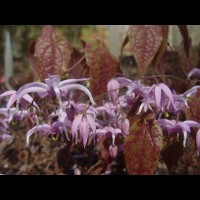
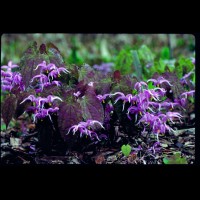
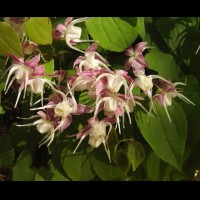
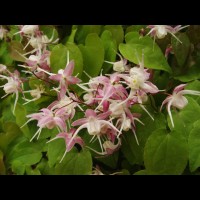
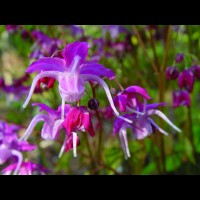

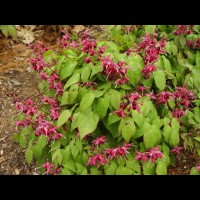
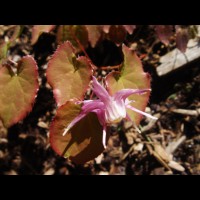
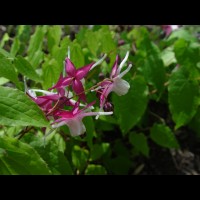
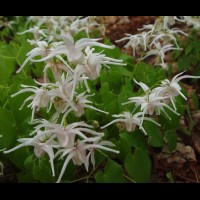
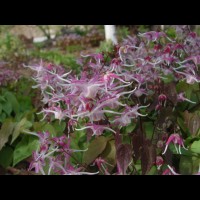
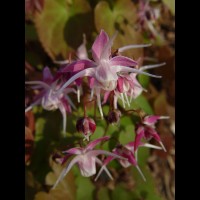
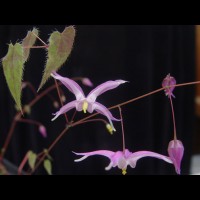
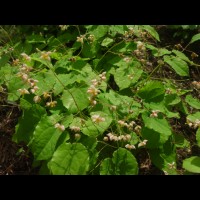

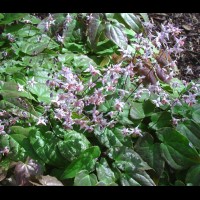
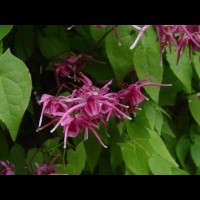
.jpg)
.jpg)
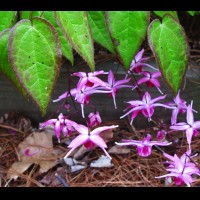
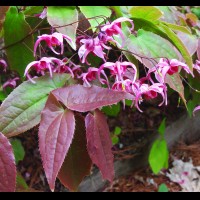
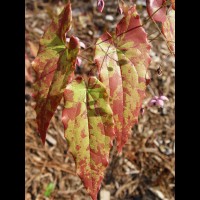


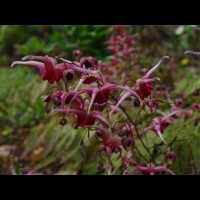
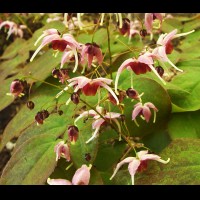
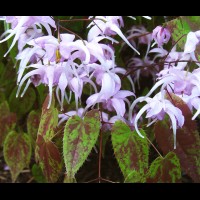
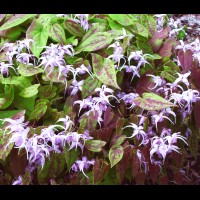
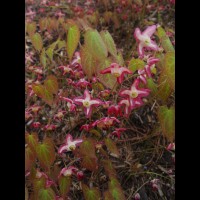
.jpg)
.jpg)
